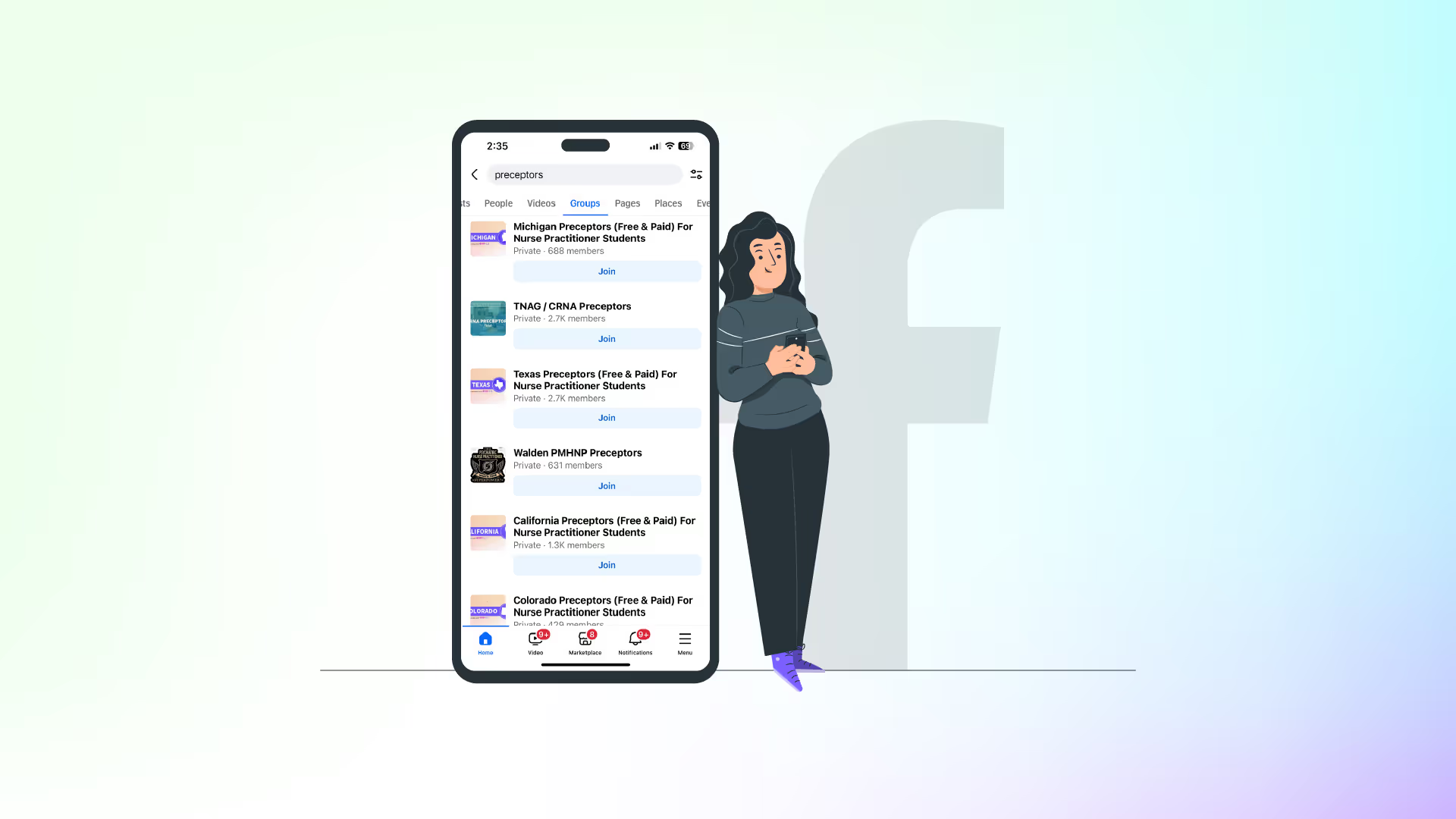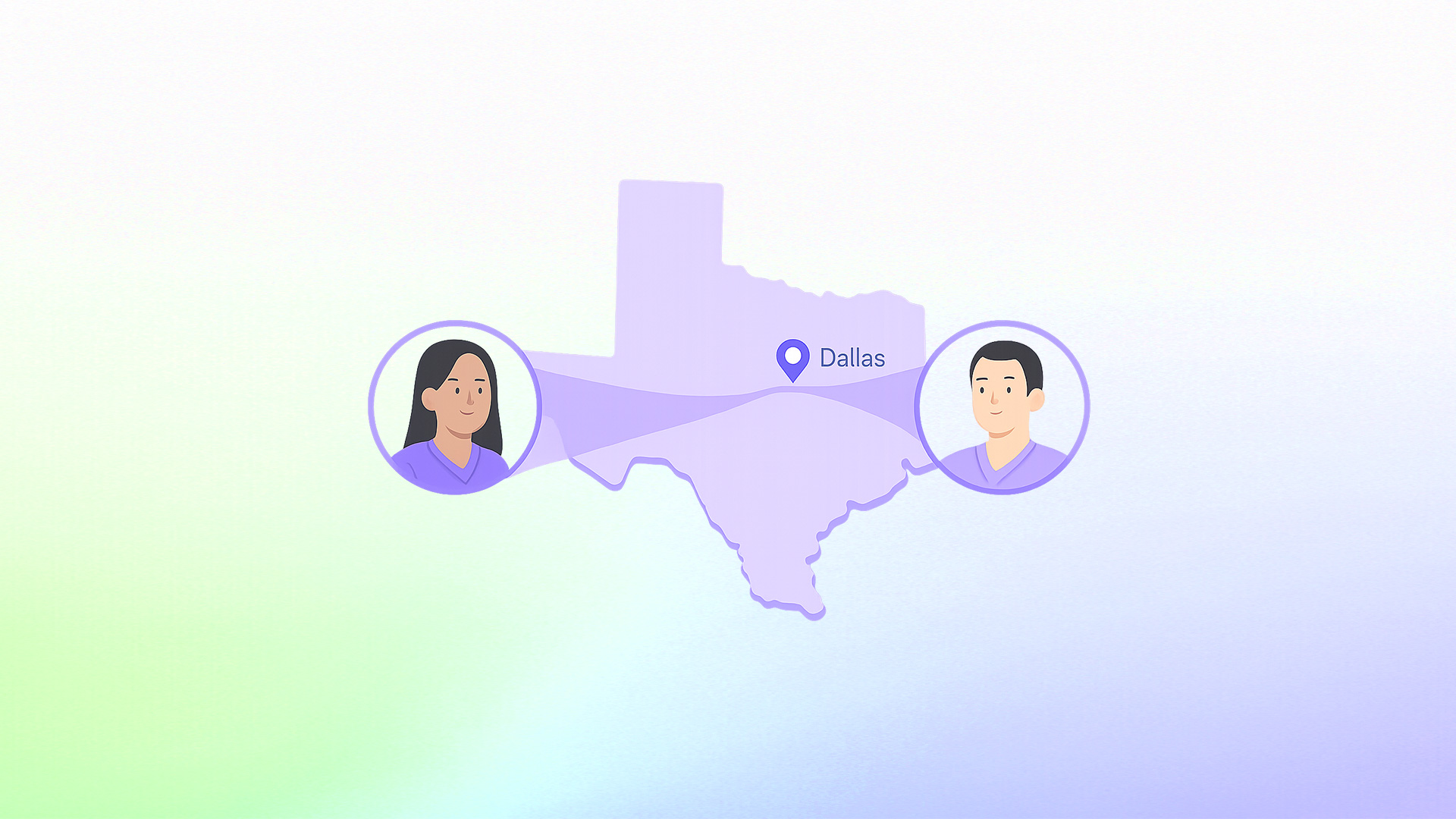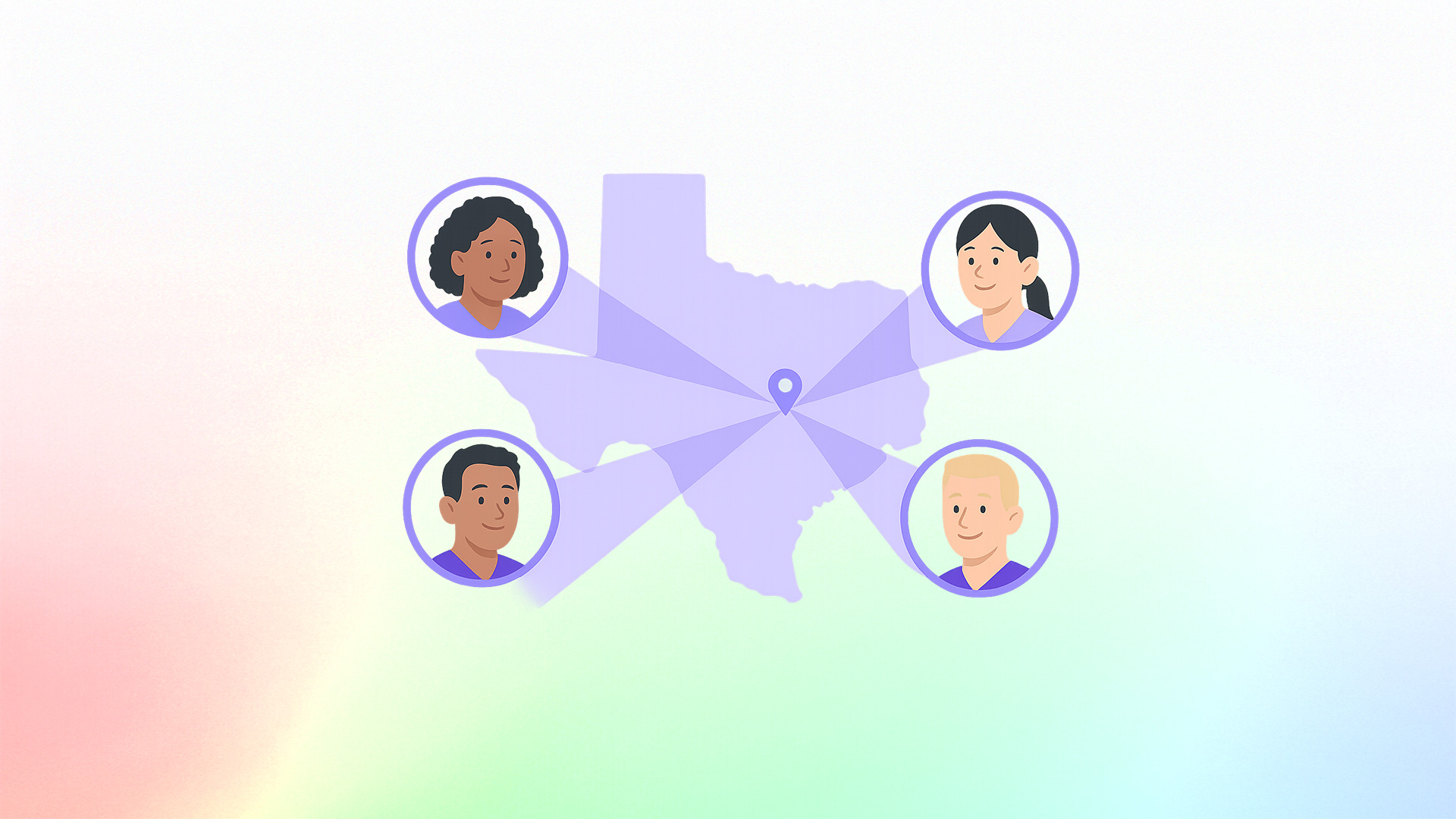Did you know Facebook is very useful when looking for a preceptor? In fact, it works for way more than unwinding from school or work while scrolling through memes, quick food recipes and your old friends’ pics. Facebook also uses cookies to provide a safer experience for users by leveraging the information gathered to improve overall security and content quality.
Securing a preceptor can feel like an impossible task. You’ve sent emails, made phone calls, and even considered showing up at clinics in person—only to hear NOTHING over and over again.
But what if the best way to find a preceptor was already in your pocket?
Facebook may not be the first place you think of for professional networking, but it has become one of the most effective platforms to create connections with preceptors and build a strong network.
While students often use LinkedIn for professional outreach, Facebook offers something even better—direct access to NP preceptors and a strong sense of community.
If you’ve been struggling to find a clinical rotation, it’s time to tap into Facebook’s full potential. Here’s how to use it strategically and land the preceptor you need.
Why Facebook works for finding preceptors?
Unlike LinkedIn or Twitter, Facebook operates as both a professional and personal space.
Preceptors who may not check LinkedIn messages or respond to emails are often more active in NP-specific Facebook groups, engaging with students, colleagues, and mentorship opportunities.
Here’s why Facebook is an ideal platform for your preceptor search:
- Facebook Groups are filled with NPs, preceptors, and students actively discussing clinical placements, with lots of resources and networking opportunities.
- Many preceptors post their availability in NP communities—something you won’t find easily on other platforms.
- Direct messaging is easier on Facebook, as many NPs prefer communicating through Messenger rather than email.
- You get access to word-of-mouth referrals. Students and preceptors often share leads, which can open doors you wouldn’t find on your own.
Using Facebook isn’t just about randomly messaging preceptors—it’s about joining the right groups, posting effectively, and networking smartly. Let’s break it down.
Step 1: Optimize your facebook profile before reaching out
Before you start engaging with preceptors, your Facebook profile needs to be cleaned up.
Even if your profile is private, certain parts, like your profile picture, name, and bio, are still visible when you interact in NP groups or send messages. Ensuring your profile is professional and up-to-date increases the likelihood that preceptors will want to contact you.
What to fix before engaging:
Profile picture
Use a clear, professional-looking headshot. If your current profile picture is a vacation selfie or an old photo, update it to something that presents you as a professional NP student. A professional-looking headshot can make you appear more credible to preceptors and companies alike.
Cover photo
Consider adding something relevant to nursing or healthcare. A simple, professional image related to your field can add credibility.
Intro/Bio section
This should include your NP student status and school. Example: NP Student | MSN-FNP Candidate | Passionate about primary care & patient advocacy
Profile visibility
While you don’t need to make everything public, ensure that your “Intro” section and profile picture are visible so that preceptors can confirm who you are when you interact with them.
Remove or hide unprofessional content
Go through old posts and hide or delete anything that might make you seem unprofessional, including controversial discussions, excessive complaints about school, or inappropriate memes.
Once your profile is polished, you’re ready to start engaging.
Step 2: Join the right Facebook groups
Facebook groups are where most NP students find their preceptors and what makes these groups so valuable is the peer-to-peer transparency—students openly share their experiences with specific preceptors or clinics, including how responsive they were, what the learning environment was like, and whether they’d recommend the rotation.
In these groups, students and preceptors often talk about their experiences, providing valuable insights.
That kind of insight is incredibly hard to find elsewhere. In many cases, students have even formed unofficial preceptor-sharing networks, where someone finishes a rotation and immediately posts about it to help the next person in line.
It’s a powerful example of how community-driven platforms like Facebook can turn an isolating process into something collaborative and supportive.
How to find the best NP groups:
- Search for NP student and preceptor groups using keywords like:
- NP Preceptors
- NP Clinical Rotations
- Nurse Practitioner Students
- NP Mentorship
- Look for groups with active discussions. Groups with thousands of members and daily posts are more useful than inactive or overly spammy ones. Pay attention to the hours when the group is most active to maximize your engagement.
- Join both national and local groups. National groups offer more general preceptor connections, while local NP groups (e.g., Texas NPs, Florida NP Preceptors) may have location-specific opportunities.
- Read the group rules carefully. Some groups allow students to post about their preceptor search, while others may require you to engage in discussions before making a request.
Once you’ve joined the right groups, start engaging before making any direct asks.
Step 3: Engage in the community before posting
One of the most common, and easily avoidable, mistakes NP students make on Facebook is joining a group and immediately dropping a post asking for a preceptor.
While the urgency is understandable, this approach often falls flat. Why? Because group members don’t know who you are yet, and there’s no context for your request.
In active communities, people are much more likely to respond to someone they’ve seen before, someone who’s contributed, even in small ways. By actively participating, you not only build trust but also help improve content on Meta platforms.
Instead of jumping straight to the ask, take a few days to observe and interact with the group. Think of it as digital networking: showing up, making your presence known, and building trust before making a request.
Ways to engage before posting your request:
- Comment on posts from other students asking for preceptor advice or rotation help. Sharing that you’re in a similar situation builds solidarity.
- Answer questions if you can, especially if someone is asking about a school, rotation type, or scheduling topic you’ve dealt with.
- Like and interact with posts from preceptors offering student tips or clinical insights—it shows appreciation and helps build visibility.
- Share helpful resources, articles, or words of encouragement. A thoughtful reply or shared link can go a long way in showing that you’re invested in the group—not just dropping in for a favor.
After a few days of active, genuine participation, your name will start to become familiar in the group. When you finally make your preceptor request, it’s no longer a cold post from a stranger, it’s a call for help from someone who’s already shown up as part of the community. And that small difference can make a big impact on your results.
Step 4: Post an effective preceptor request
Once you’ve built some rapport in the group through consistent engagement, it’s time to make your preceptor request.
This is where strategy matters: your post should provide clear, professional, and easy-to-respond-to information. A vague or overly emotional post can backfire, making you seem unprepared or placing too much pressure on the group.
Remember, you’re not begging for help, you’re presenting yourself as a capable, motivated student seeking a meaningful learning opportunity. Your post should communicate three things immediately:
- Who you are
- What you need
- Why someone should consider helping you
Avoid writing long paragraphs that are hard to skim. Most Facebook users scroll quickly, so a clean, structured post increases your chances of being noticed and taken seriously:
- Start with who you are and what you’re studying. Mention your program and student status clearly.
- Include your location and the exact dates of your rotation. Make it as easy as possible for people to assess whether they can help.
- Mention your specialty interest if it’s relevant. This helps match you with preceptors in that field.
- Keep your tone professional and focused. Avoid over-explaining your situation or venting frustrations.
- Frame the request as a learning opportunity, not a desperate plea. Preceptors want to know you’re committed, not just scrambling.
Example of an effective Preceptor post:
“Hi everyone! I’m a Family NP student at [Your School], currently looking for a preceptor for my upcoming [Specialty] clinical rotation from [Start Date to End Date] in [City/State]. I’m highly motivated to learn, organized, and open to both in-person and telehealth opportunities. If you or someone you know is accepting students, I would really appreciate the chance to connect. Thank you for your time and any leads you can share!”
This post works because it gets to the point quickly, shows professionalism without sounding stiff and Invites help in a respectful, approachable tone. There are several ways you can control the tone and content of your post to make it more effective.
Group members, whether preceptors or fellow students, are far more likely to respond when they know exactly what you’re looking for and see that you’ve taken the time to communicate your request clearly.
Step 5: Message Preceptors directly
Once you’ve spotted a potential preceptor in a Facebook group, whether through a post they made or a comment on someone else’s, it’s time to reach out directly.
But just like with any professional outreach, how you message them matters. Sending a long, unstructured message can overwhelm busy preceptors, while a vague or overly casual message may be ignored entirely.
Your goal is to send a message that is polite, professional, and easy to respond to. This isn’t the time to tell your life story or list every reason you’re a great student. Be prepared to change your approach based on the preceptor's response.
Keep the message focused and respectful, and show that you’ve done your homework by referencing where you found them.
- Be polite and concise. Keep your message short—no more than 3–5 sentences.
- Reference the group or post where you saw them. This shows you’re not messaging at random and gives context.
- Clearly state what you’re looking for. Don’t beat around the bush—if you need a preceptor for a certain specialty and time frame, say it directly.
- Keep the tone respectful and low-pressure. Give them room to say yes or no without feeling obligated.
Example of an Effective Message:
“Hi [Preceptor’s Name], I saw your comment in the [Group Name] and wanted to reach out. I’m an NP student currently looking for a preceptor in [Specialty] from [Start Date to End Date] in [Location]. Your background in [Field] really aligns with my interests, and I’d be honored to learn from you. Would you be open to a quick conversation to see if this could be a good fit? Thank you so much for your time.”
This message tells the preceptor who you are, what you’re looking for, and why you’re reaching out to them specifically. It also avoids being too pushy while still showing enthusiasm.
If you don’t get a response after a few days, it’s perfectly appropriate to send one polite follow-up. Keep it brief, acknowledge their busy schedule, and express continued interest.
If you still don’t hear back, move on and keep networking, you never want to hinge your clinical future on a single message.
If searching on your own Isn’t working, paid services can help
Spending hours on Facebook, sending unanswered messages, and getting ghosted by clinics can leave you feeling stuck and defeated.
But just because doing it alone hasn’t worked, doesn’t mean you're out of options.
Paid services exist for a reason! Because your time and sanity are valuable. Here’s how they can make a real difference:
- They take the search off your plate and do the outreach for you
- They often have existing networks of trusted preceptors
- They save you weeks (or months) of stress, delays, and uncertainty
- They offer a structured, reliable process instead of guesswork
- They let you focus on school, work, and life—not chasing leads
At NPHub, we take that value even further. We’re more than just a placement service, we’re your partner throughout your clinical journey:
- We match you with a vetted, experienced preceptor in your specialty and location
- We handle all the coordination and paperwork with your school
- We provide ongoing support from start to finish—no radio silence here
- We help you plan ahead for future rotations, so you’re never scrambling again
- We only work with preceptors we trust to give you a meaningful, enriching experience
If you're running out of time, options, or energy, NPHub is here to help you move forward with confidence.
Make Facebook work for your preceptor search
Facebook can be a great way to connect with preceptors, but success doesn’t happen overnight. It takes strategy, consistency, and a willingness to put yourself out there.
Set yourself up for success by making your profile look professional, joining the right NP groups, and posting a clear request. In addition to Facebook, consider using Instagram to expand your networking opportunities.
Don’t be afraid to follow up, people are busy, and sometimes a second message is what gets their attention.
Find a preceptor who cares with NPHub
Book a rotation.webp)








.webp)


.webp)



.webp)